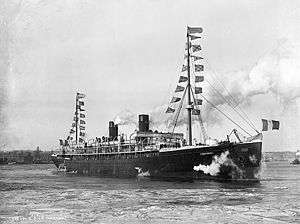SS La Touraine
 | |
| History | |
|---|---|
| Name: | SS La Touraine |
| Namesake: | former province of Touraine |
| Owner: | Compagnie Générale Transatlantique |
| Builder: |
|
| Launched: | 21 March 1890 |
| Maiden voyage: | Le Havre–New York, 20 June 1891 |
| Fate: | Scrapped October 1923 |
| General characteristics | |
| Tonnage: |
|
| Length: | 158.55 m (520 ft 2 in) LBP |
| Beam: | 17.07 m (56 ft 0 in) |
| Speed: | 19 knots (35 km/h) |
SS La Touraine was an ocean liner that sailed for the Compagnie Générale Transatlantique from the 1890s to the 1920s. Built in France in 1891, she was primarily employed in transatlantic service on the North Atlantic. The liner was scrapped in Dunkirk in October 1923.
History
La Touraine was laid down by Compagnie Générale Transatlantique in Saint-Nazaire and launched 21 March 1890.[1] Built for France to New York service, she was the fifth-largest steamer in the world at the time of her launch.[2] She had a 8,893 gross tonnage (GT) and measured 158.55 metres (520 ft 2 in) long between perpendiculars, and was 17.07 metres (56 ft 0 in) wide. Equipped with twin triple-expansion steam engines driving two screw propellors that drove her at 19 knots (35 km/h), she was outfitted with two funnels and four masts. La Touraine was initially equipped with accommodations for 392 first-class, 98 second-class, and 600 third-class passengers. La Touraine sailed on her maiden voyage from Le Havre to New York on 20 June 1891.[1]
In September 1892, a cholera outbreak, traced to a United States immigrant brought aboard the Hamburg-Amerika steamer Moravia, caused all steerage traffic to be suspended and CGT's New York traffic to depart from Cherbourg for the next two months.[3]
On 2 March 1900, La Touraine ran-down the sailing trawler 'Briton' of Brixham, Devon, in the English Channel near the Eddystone light. The trawler's entire five man crew was lost.[4]
From November 1900 to January 1902, La Touraine was refitted at Saint-Nazaire to 8,429 GT. Her engines were overhauled, she had bilge keels installed, and two masts removed. Her third-class passenger capacity was increased to 1,000. On 21 January 1903, La Touraine was damaged at Le Havre by a fire that destroyed her grand staircase, the first-class dining room, and her "de luxe" cabins, all of which were later rebuilt.[1] In 1906, La Touraine was still on the New York route, sailing opposite La Savoie and La Lorraine.[5] In 1910 her passenger capacity was reduced, accommodating 69 first-, 263 second-, and 686 third-class passengers.[1] On April 12th, 1912 while on a transatlantic voyage La Touraine was one of a number of ships that related wireless radio warnings about icebergs to the RMS Titanic shortly before that ship's now-famous collision with an iceberg.
In May 1913, she began sailing from Le Havre to Montreal via Quebec carrying only second- and third-class passengers.[1] In October 1913, while still on this route, she was one of ten ocean liners that came to the aid of the stricken Uranium Line steamer Volturno that had caught fire. During the rescue efforts, La Touraine came within 15 feet (4.6 m) of colliding with the Red Star liner Kroonland, also participating in the rescue attempt.[6] La Touraine began her fifth and final round trip on the Montreal run in June 1914.[1]
At the outbreak of World War I, the French government took over many of CGT's liners—including La Touraine—for a variety of duties.[7] At some point after being released from government service, La Touraine resumed Le Havre–New York service, and again carried first-class passengers, until March 1915.[1] After the German invasion of France in April 1915, CGT shifted its base of operations to Bordeaux;[7] La Touraine began Bordeaux–New York service in at that time, remaining on that route until September 1919, when the war's end allowed the resumption of departures from Le Havre. After resuming Le Havre–New York service, La Touraine carried cabin- and third-class passengers only through her last voyage in September 1922.[1] With the post-war boom in North Atlantic traffic over,[8] CGT sold La Touraine. The liner was scrapped in Dunkirk in October 1923.[1]
Notes
References
- Bonsor, N. R. P. (1978) [1955]. North Atlantic Seaway, Volume 2 (Enlarged and completely revised ed.). Saint Brélade, Jersey: Brookside Publications. ISBN 0-905824-01-6. OCLC 29930159.
External links
- La Touraine page at The Great Ocean Liners
- Video dedicated to SS La Touraine
- Pages relating to La Touraine's rescue of survivors of the burning and sinking of SS Volturno from The burning of the 'Volturno':
- Photos of La Touraine, information about crewmen aboard La Touraine that received medals for Volturno rescue
- Photos of La Touraine, information about Volturno survivors rescued by La Touraine
- More photos of La Touraine
- Information on the construction of La Touraine from a contemporary source
- More photos of La Touraine